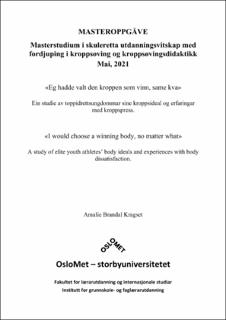| dc.contributor.advisor | Walseth, Kristin | |
| dc.contributor.author | Brandal Kragset, Amalie | |
| dc.date.accessioned | 2021-10-13T08:03:18Z | |
| dc.date.available | 2021-10-13T08:03:18Z | |
| dc.date.issued | 2021 | |
| dc.identifier.uri | https://hdl.handle.net/11250/2789518 | |
| dc.description.abstract | Denne masteroppgåva rettar søkjelyset mot toppidrettsungdommar sine kroppsideal og erfaringar med kroppspress. Det teoretiske rammeverket tek utgangspunkt i operasjonaliseringa av tre viktige omgrep for studien si problemstilling: kroppsbilete, kroppsideal og kroppspress. Eg har utfylt rammeverket med tidlegare nasjonal og internasjonal forsking på feltet ungdom og kropp, med fokus på skilnadar i ulike subkulturar og idrettsungdommar sin eigenart. Eg har valt ei kvalitativ tilnærming, og det kvalitative, semistrukturerte forskingsintervjuet er grunnlaget for oppgåva sin empiri. Utvalet består av sju toppidrettsungdommar i alderen 16-17 år, innanfor ulike idrettar og med ulike erfaringar. Intervjua vart analyserte ved bruk av ein tematisk analyse, der eg induktivt koda materialet med utgangspunkt i empirien. På denne måten kunne eg identifisere, tolke og presentere funn i datamaterialet. Resultata mine viser at idretten ein driv med har stor påverknad på kroppsidealet. Dette kjem til syne mellom anna i deltakarane sine teikningar av den perfekte kroppen. Idrett var ikkje nemnd som ein del av oppgåva, men alle knytte idealkroppen til idretten, og til det å kunne prestere. Nasjonal litteratur på feltet skildrar ein idealkropp prega av fokus på utsjånad, men empirien i denne studien peikar motsett veg: Fokuset dreiar seg i stor grad om kroppen sin funksjon. Kroppspress er eit gjennomgåande i studien, og alle deltakarane ytrar, på ulike måtar, eit ynske om å endre på kroppen grunna funksjon eller utsjånad. Det er difor liten tvil om at det eksisterer eit visst press på deltakarane knytt til korleis kroppane deira skal prestere og/eller sjå ut. Her er motiva noko splitta: Noko kjem frå idretten, noko frå det sosiale idealet utanfor idretten. Funna i studien indikerer at det finst to ulike kroppsideal hjå toppidrettsungdommane: eit idrettsleg og eit sosialt. Desse ideala kan vere motstridande, men er med på å legge føringar for korleis ungdommane ynsker å sjå ut. Jentene fortel om store skilnadar mellom dei to ideala, medan gutane opplever at det ofte er eit samsvar. Dette gjer at jentene prøver å balansere muskelmassen ein treng for å prestere i idretten med forventingane frå samfunnet elles om korleis kroppen burde sjå ut. Studien viser likevel at fleirtalet av jentene har eit kroppsideal som tek utgangspunkt i idretten, og at det sosiale idealet utanfor idretten er mindre relevant. Dette funnet indikerer at toppidrettsjenter er i ferd med å få eit meir muskuløst kroppsideal. | en_US |
| dc.description.abstract | This master thesis highlights the body ideals of elite youth athletes and their experiences with body dissatisfaction. Consequently, the research question is: “What are the body ideals of elite youth athletes and what are their experiences with body dissatisfaction?” The theoretical framework starts with the operationalization of three important keywords: body image, body ideal and body dissatisfaction. The theoretical framework has been complemented by previous research on youth and body, focusing on differences in subcultures and the specific traits of youth athletes. I use a qualitative approach, and the qualitative, semi-structured interview is the basis for the study. The sample consists of seven elite youth athletes aged 16-17. The interviews were analyzed through a thematic approach in which I inductively coded the data, allowing me to identify, interpret and present themes found in the data. The results show that the individual sport itself has a major impact on the body ideal of elite youth athletes. All the participants linked their body ideal to their sport, or more precisely: to being able to perform. Previous literature within the field describes a body ideal characterized by a marked focus on aesthetic appearance. The results in this study point in the opposite direction, however: The youths’ body ideals are mostly characterized by the degree to which their bodies can perform and function within their respective sports. Body dissatisfaction reappears as a theme throughout the study. All the participants imparted a wish to transform or change their bodies due to function or appearance. Thus, there is little doubt that there exists a certain pressure on the participants regarding how their body is supposed to perform and/or look. The study presents different motives, some from within the individual sports and some from the social body ideal. The study confirms the existence of two different body ideals for elite athletes: a sport ideal and a social ideal. These set the standard for how the youths wish to look, but the two ideals can be contradictory. The girls describe a divergence between the ideals, whereas the boys experience that there is a coherence. The study nevertheless shows that the body ideal of elite girl athletes arises from their sport of choice, and that the social ideal outside the sport is less relevant. This finding indicates that elite female athletes are approaching a more muscular body ideal. | en_US |
| dc.language.iso | nno | en_US |
| dc.publisher | OsloMet - Storbyuniversitetet | en_US |
| dc.subject | Ungdommer | en_US |
| dc.subject | Toppidrett | en_US |
| dc.subject | Livsmestring | en_US |
| dc.subject | Kroppsidealer | en_US |
| dc.subject | Kroppspress | en_US |
| dc.title | «Eg hadde valt den kroppen som vinn, same kva». Ein studie av toppidrettsungdommar sine kroppsideal og erfaringar med kroppspress | en_US |
| dc.title.alternative | «I would choose a winning body, no matter what». A study of elite youth athletes’ body ideals and experiences with body dissatisfaction | en_US |
| dc.type | Master thesis | en_US |
| dc.description.version | publishedVersion | en_US |
| dc.source.pagenumber | 102 | en_US |
| dc.subject.nsi | VDP::Samfunnsvitenskap: 200::Pedagogiske fag: 280::Fagdidaktikk: 283 | en_US |
